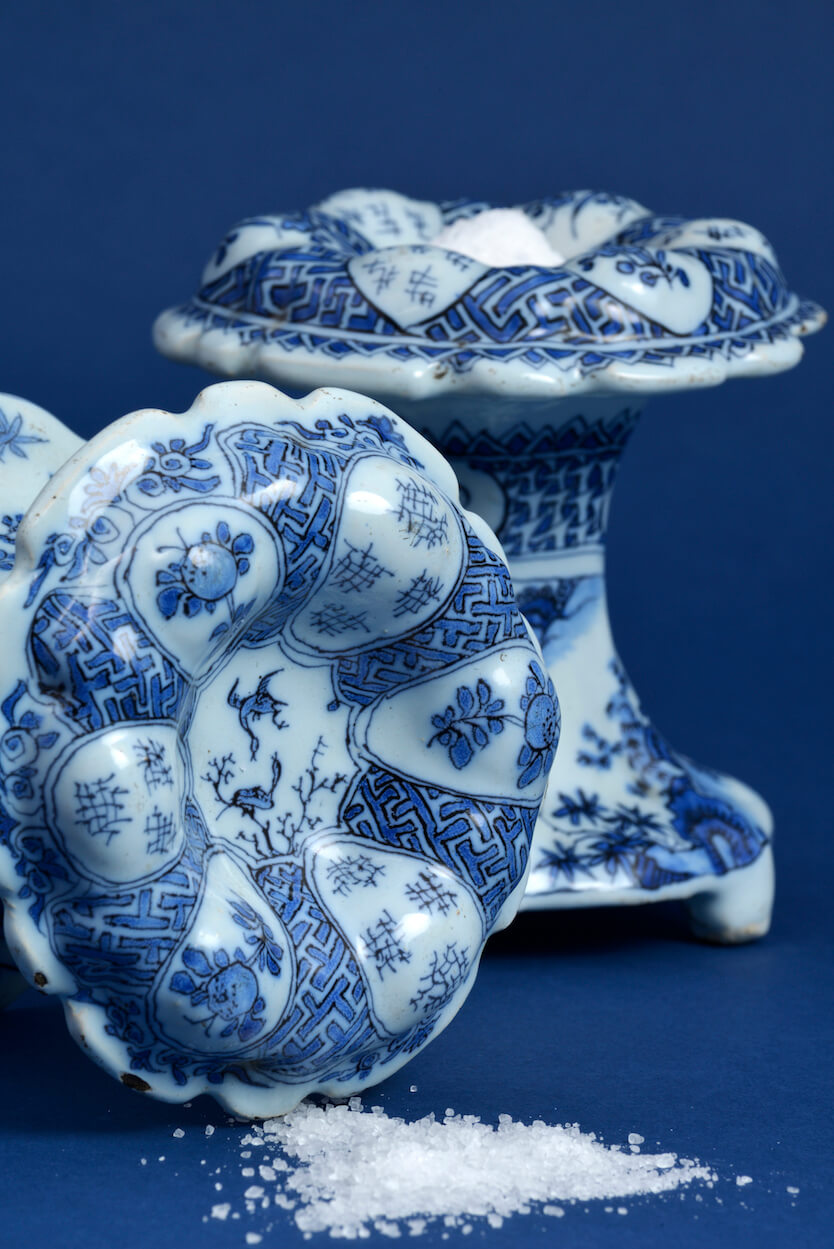
Delftware Salt Cellars
Salt has been an invaluable commodity for thousands of years, used to preserve and flavor food and traded as currency. In Asia, salt has been used in pickling and preserving foods for over 5000 years, and for at least 2000 years in the West. It was used by the ancient Egyptians in mummification during the 2nd millennium BC. The Ancient Greek historian Herodotus described salt caravans making their way across the Libyan desert, a sign of how vital the salt industry and trade were. Universally valuable, salt became used as an international currency. Ancient Roman soldiers received a payment of salt, and the Latin word for salt, salarium, forms the root of the word “salary” as a result. Salt was the one of the first items taxed, in China around 2000 BC.
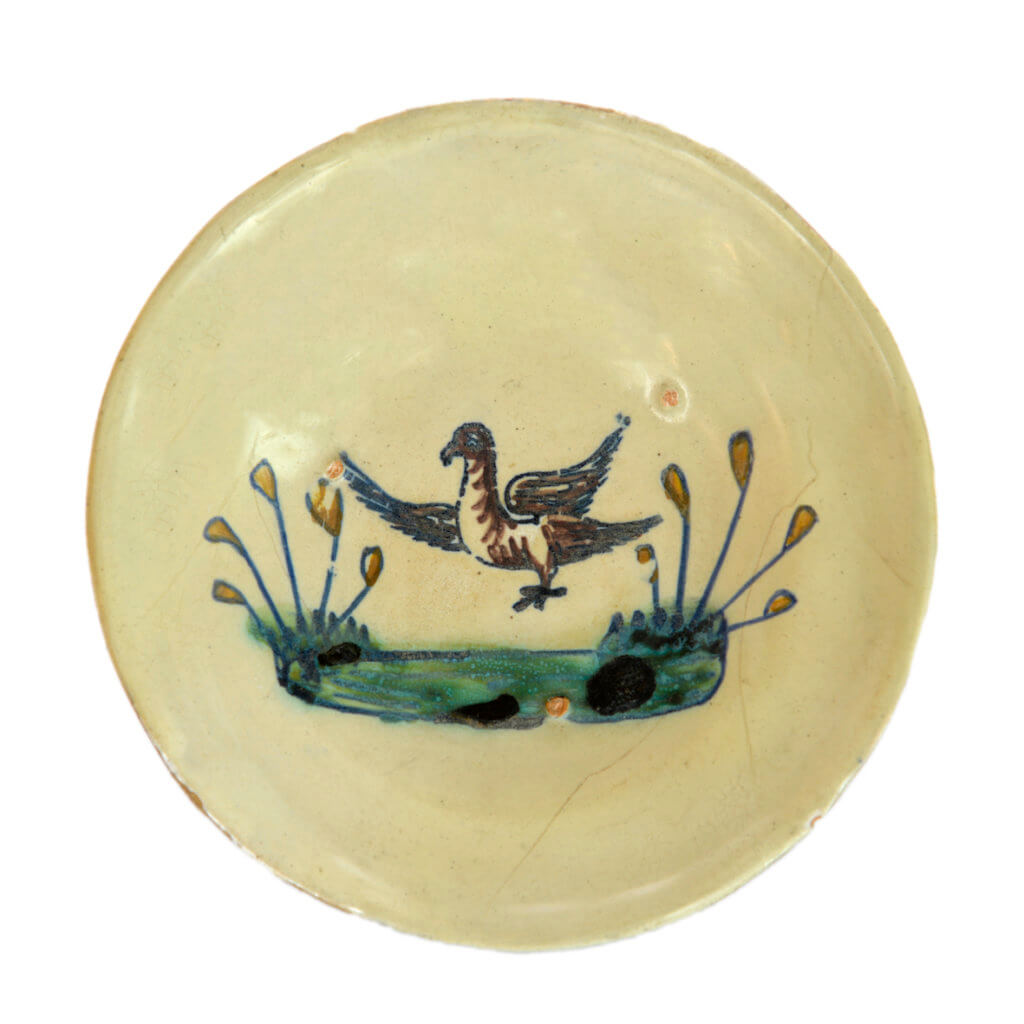 Therefore it is not surprising that salt was an important centerpiece of both the Medieval and Renaissance tabletop. Salt cellars, or simply “salts,” were used to contain the precious mineral at the table, with the earliest examples found in classical Rome. At the wealthiest palaces, salt was served in ornate salt cellars that sat in front of the host or the honored guest. Small covered salt cellars were also a key feature on more modest tables. This early majolica polychrome salt cellar was made in Haarlem around 1600. The interior is delicately painted in the center with a bird flying amidst plants. Dutch majolica was the forerunner of Delftware. In the late sixteenth century potters of Italian origin migrated from Antwerp to the Northern Netherlands due to religious and political turmoil (the Fall of Antwerp in 1585). These potters settled in cities such as Haarlem and Delft, bringing with them their knowledge and skills in making Italian-style tin-glazed earthenware (majolica).
Therefore it is not surprising that salt was an important centerpiece of both the Medieval and Renaissance tabletop. Salt cellars, or simply “salts,” were used to contain the precious mineral at the table, with the earliest examples found in classical Rome. At the wealthiest palaces, salt was served in ornate salt cellars that sat in front of the host or the honored guest. Small covered salt cellars were also a key feature on more modest tables. This early majolica polychrome salt cellar was made in Haarlem around 1600. The interior is delicately painted in the center with a bird flying amidst plants. Dutch majolica was the forerunner of Delftware. In the late sixteenth century potters of Italian origin migrated from Antwerp to the Northern Netherlands due to religious and political turmoil (the Fall of Antwerp in 1585). These potters settled in cities such as Haarlem and Delft, bringing with them their knowledge and skills in making Italian-style tin-glazed earthenware (majolica).
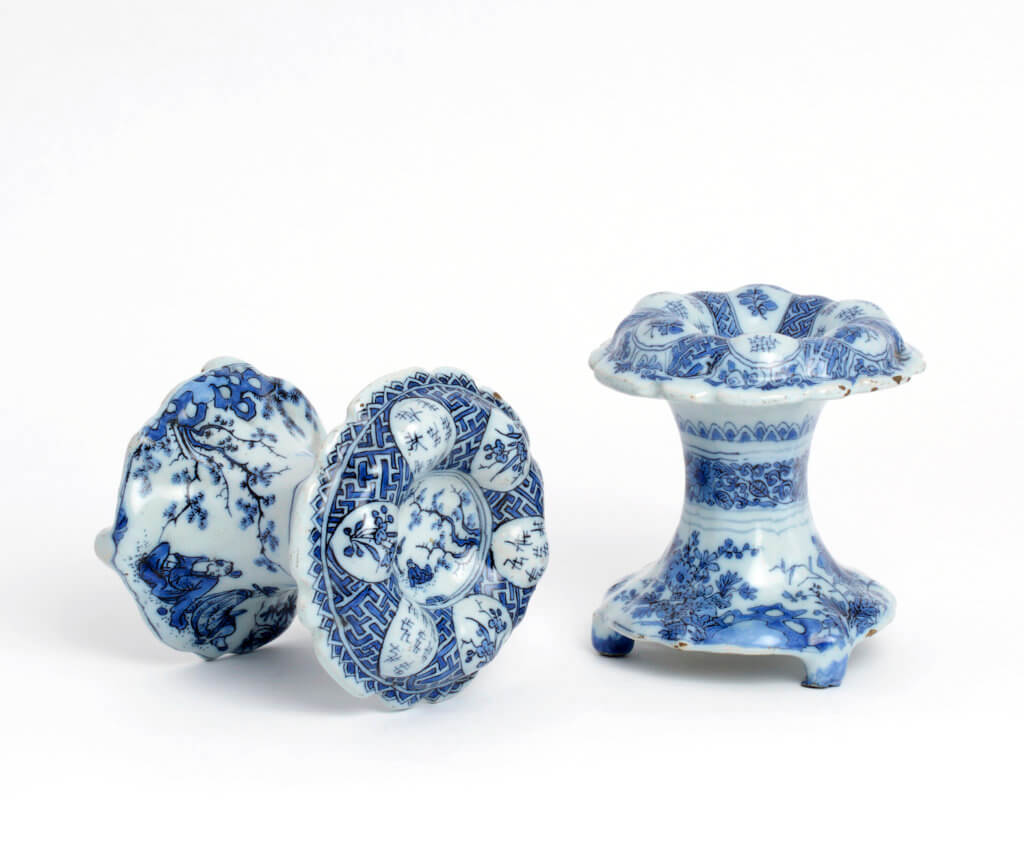 The production and trade of salt probably began in the Netherlands already in the Iron Age (0 – 500 A.D.). Salt, known as ‘white gold,’ was especially expensive during ancient times and the middle ages. Its ability to preserve and season food, such as meat, fish and vegetables, has been called “the foundation of civilization.” In Holland, where there were cold winters, people also used icehouses, but in Southern Europe, Asia and Africa it was too hot to preserve food and salt was the only solution. The early difficulty in obtaining salt turned it into an important commodity of trade and a form of international currency. The West India Company, in short WIC, was founded in 1621 to sail to the West and reap similar profits as the VOC. To ensure that there was no competition between the two companies, the WIC sailed to the west coast of Africa, and across the Atlantic Ocean to America. Salt was amongst the many products coveted by the WIC. Into modern history, salt has created and destroyed empires. For example, France’s punitive gabelle, or salt tax, installed by king Philip IV is often seen as a crucial impetus for the French Revolution of 1789.
The production and trade of salt probably began in the Netherlands already in the Iron Age (0 – 500 A.D.). Salt, known as ‘white gold,’ was especially expensive during ancient times and the middle ages. Its ability to preserve and season food, such as meat, fish and vegetables, has been called “the foundation of civilization.” In Holland, where there were cold winters, people also used icehouses, but in Southern Europe, Asia and Africa it was too hot to preserve food and salt was the only solution. The early difficulty in obtaining salt turned it into an important commodity of trade and a form of international currency. The West India Company, in short WIC, was founded in 1621 to sail to the West and reap similar profits as the VOC. To ensure that there was no competition between the two companies, the WIC sailed to the west coast of Africa, and across the Atlantic Ocean to America. Salt was amongst the many products coveted by the WIC. Into modern history, salt has created and destroyed empires. For example, France’s punitive gabelle, or salt tax, installed by king Philip IV is often seen as a crucial impetus for the French Revolution of 1789.
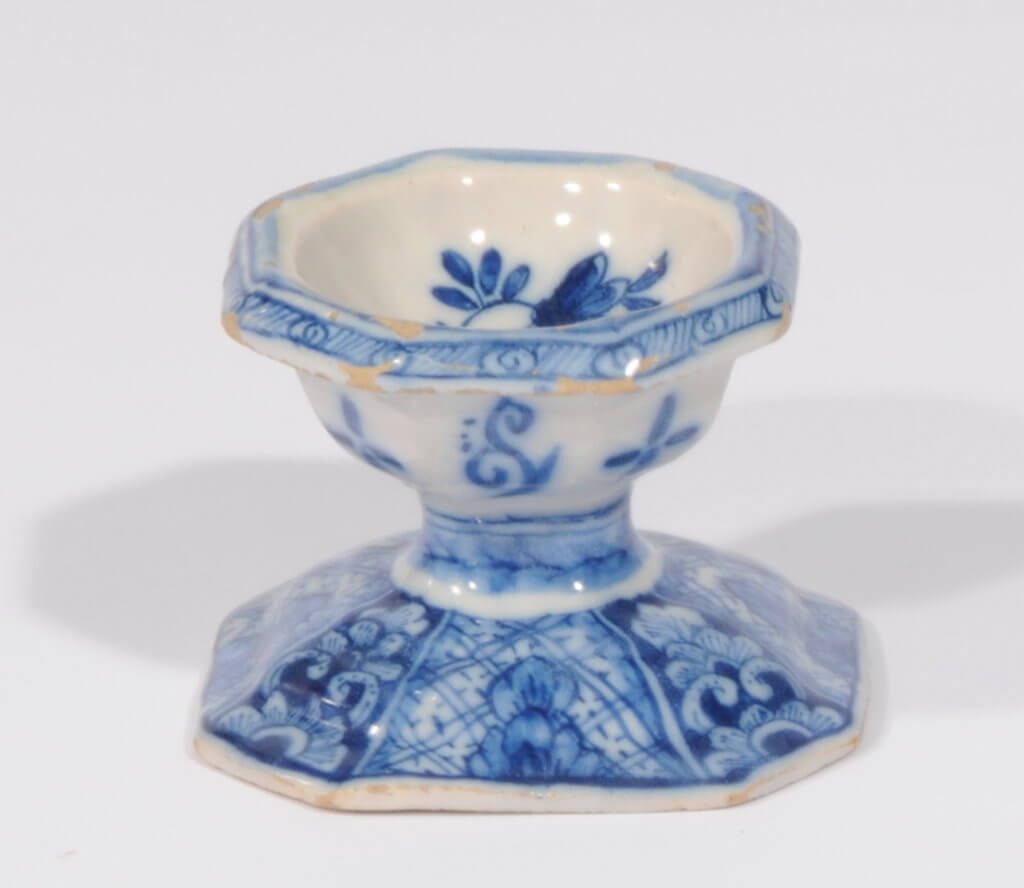 Salt cellars are especially conspicuous objects on the feast tables of medieval paintings because there was so little else on the table during the era. Over the centuries, salt became more available, but through the seventeenth and into the eighteenth century it remained an important indicator of wealth and status on the dining table. The presentation vessels were often sizable and impressive, such as these two blue and white circular salt cellars. These salt cellars, from circa 1690, bear the mark of Adrianus Kocx, the owner of De Grieksche A (The Greek A) factory from 1686 to 1701. The shape of salt cellars often derived from typical Dutch silver salts of the mid-seventeenth century. Although designed after a silver example, these blue and white salt cellars have a chinoiserie decoration, which the painter has subordinated to its shape. The well of one is painted with a seated and standing figure in a landscape of shrubbery within a roundel, the other is painted with a bird in flight above another bird perched on a branch in a twelve-angled roundel. Also, the capstan-shaped bodies are painted with chinoiserie scenes. One shows a continuous chinoiserie scene depicting two seated figures and one standing amidst a landscape of shrubbery and rocks, and the other is painted with a continuous scene of rock work and flowering branches rising from the scalloped and barbed foot rim. Furthermore, the pseudo-Chinese characters in the decoration are particularly striking.
Salt cellars are especially conspicuous objects on the feast tables of medieval paintings because there was so little else on the table during the era. Over the centuries, salt became more available, but through the seventeenth and into the eighteenth century it remained an important indicator of wealth and status on the dining table. The presentation vessels were often sizable and impressive, such as these two blue and white circular salt cellars. These salt cellars, from circa 1690, bear the mark of Adrianus Kocx, the owner of De Grieksche A (The Greek A) factory from 1686 to 1701. The shape of salt cellars often derived from typical Dutch silver salts of the mid-seventeenth century. Although designed after a silver example, these blue and white salt cellars have a chinoiserie decoration, which the painter has subordinated to its shape. The well of one is painted with a seated and standing figure in a landscape of shrubbery within a roundel, the other is painted with a bird in flight above another bird perched on a branch in a twelve-angled roundel. Also, the capstan-shaped bodies are painted with chinoiserie scenes. One shows a continuous chinoiserie scene depicting two seated figures and one standing amidst a landscape of shrubbery and rocks, and the other is painted with a continuous scene of rock work and flowering branches rising from the scalloped and barbed foot rim. Furthermore, the pseudo-Chinese characters in the decoration are particularly striking.
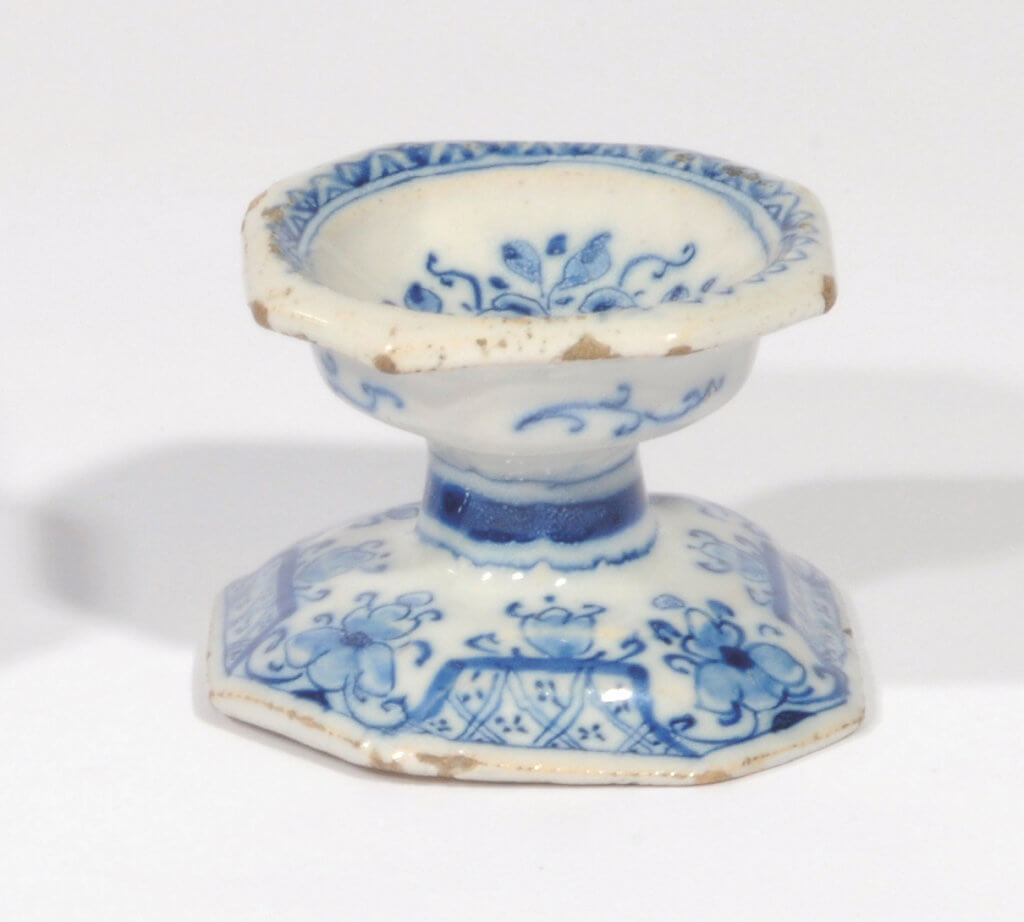 With the development of dinner services in the eighteenth century, including their array of various useful and often ornamental wares, such as candlesticks, cruet stands, sauceboats and every style of dish and plate, the salt cellars became smaller and more numerous on the table. The large single standing salt cellars had fallen out of fashion, and were used only ceremonially on special occasions. Although the salt cellars became smaller in size, their decoration was as elaborate as on the earlier ones. This blue and white salt cellar from circa 1720 is an example of these smaller salts that were used in the eighteenth century. It is marked for Jan Gaal, the owner of De Twee Scheepjes (The Two Little Ships) factory from 1707 until 1725, or his widow Lijsbeth Gaal-van der Plank from 1725 through 1727. Its circular well is painted with a flowering branch and also the exterior is decorated with foliate devices, demi-blossoms and leaves. Another similarly shaped blue and white salt, which is also decorated with floral devices and foliate scrolls, is marked for Cornelis Brouwer, the owner of De Witte Ster (The White Star) factory from 1724 to 1738. Both salt cellars are inspired by silver models.
With the development of dinner services in the eighteenth century, including their array of various useful and often ornamental wares, such as candlesticks, cruet stands, sauceboats and every style of dish and plate, the salt cellars became smaller and more numerous on the table. The large single standing salt cellars had fallen out of fashion, and were used only ceremonially on special occasions. Although the salt cellars became smaller in size, their decoration was as elaborate as on the earlier ones. This blue and white salt cellar from circa 1720 is an example of these smaller salts that were used in the eighteenth century. It is marked for Jan Gaal, the owner of De Twee Scheepjes (The Two Little Ships) factory from 1707 until 1725, or his widow Lijsbeth Gaal-van der Plank from 1725 through 1727. Its circular well is painted with a flowering branch and also the exterior is decorated with foliate devices, demi-blossoms and leaves. Another similarly shaped blue and white salt, which is also decorated with floral devices and foliate scrolls, is marked for Cornelis Brouwer, the owner of De Witte Ster (The White Star) factory from 1724 to 1738. Both salt cellars are inspired by silver models.
It is hard to imagine that salt, which is today a mass product at a bargain price, was just a few hundred years ago much more valuable that this so-called ‘white gold’ was presented in the most beautiful salt cellars that functioned as a true centerpiece on the dinner table.



